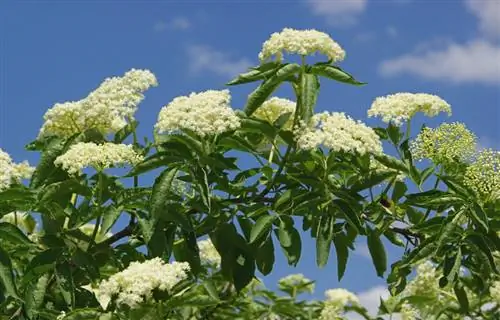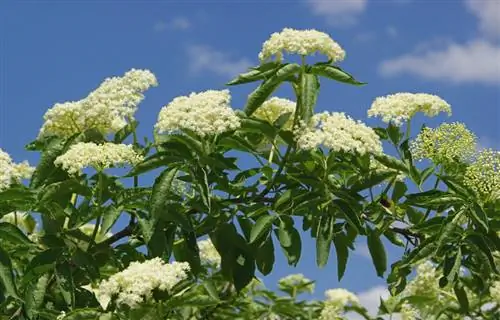- Author admin [email protected].
- Public 2023-12-16 16:46.
- Last modified 2025-01-23 11:20.
All elderberry species are shallow-rooted. This property has far-reaching consequences in the garden. Find out here what you need to consider when planting elderberry in terms of the root system.

How do elderberry roots spread in the garden?
Elderberry species are shallow-rooted and have an extensive, radiating root system near the surface of the earth. To avoid damage to walls or sidewalks, a distance of at least 300 cm should be maintained and a root barrier made of geotextile should be installed around the plant.
What characterizes a shallow-rooted plant?
Typical for a shallow-rooted plant is the radial spread just below the surface of the earth. Instead of anchoring itself in the depths of the soil, the elderberry relies on a large root system. In a well-established specimen, the thick root strands with a dense network of fine roots extend far beyond the tree disc.
In this way, an elderberry keeps away annoying competition, which makes it susceptible to windthrow. At the same time, due to its growth, it hinders the species-specific development of other plants in the garden. As if that weren't enough, a shallow-rooted elderberry causes damage to sidewalks, walls and buildings by growing underneath and lifting them up.
How to limit damage caused by elderberry roots
Even a powerful black elder will not damage your massive house. The situation looks different if the wild fruit tree is located near a garden pavilion, a terrace or paved paths. In this case, the first thing that matters is the correct distance. Place the shrub at least 300 centimeters away from paved surfaces and masonry.
To be on the safe side, surround the elderberry with a root barrier. Ideally, you should take this measure in conjunction with planting. Installation is also possible later. A root barrier is made of non-rotting geotextile (€36.00 on Amazon) and should be 1.5 to 2.0 millimeters thick. This is how to lay it correctly:
- lay out a tape measure or a garden hose within a suitable radius for orientation
- Dig a trench with a spade in circular stages up to 50 centimeters deep
- straighten the edges of the trench with pruning shears by cutting off any protruding roots
- insert the root barrier, align it and fix it with an aluminum rail
- the ends of the geotextile must overlap by at least 10 centimeters
After installation, the root barrier should protrude 5 centimeters from the ground so that the elderberry roots do not climb over it later. Finally, fill the trench with soil. The elderberry is planted within the resulting island.
Tips & Tricks
A good rule of thumb for measuring the radius within the root barrier is: The expected growth height corresponds to the minimum island area in square meters.






